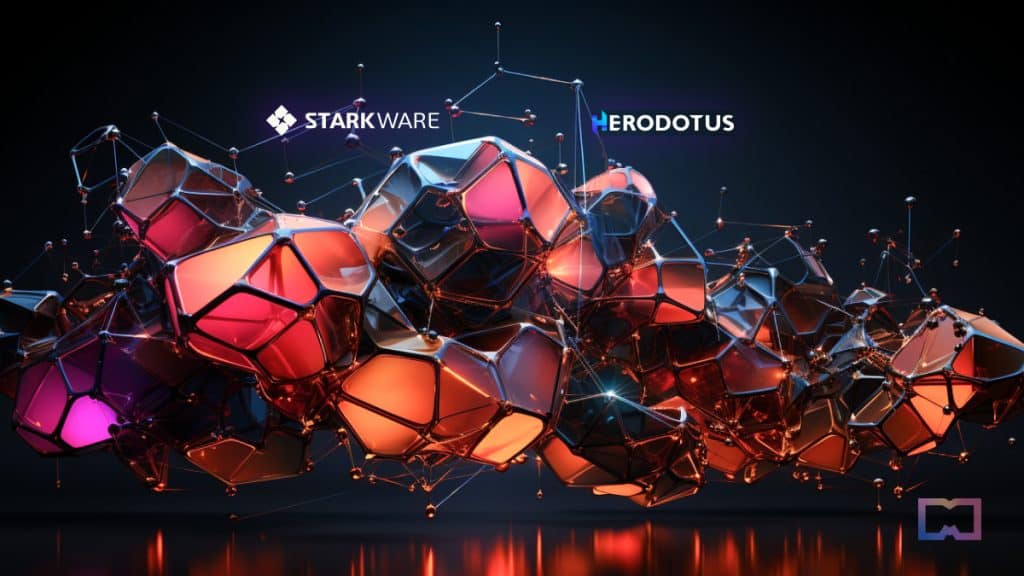Ethereum’s Entire History Now Verifiable with Herodotus and StarkWare’s On-Chain Accumulator


In Brief
The on-chain accumulator, introduced at the Starkware Summit in San Francisco on August 31, represents a monumental achievement for the Ethereum ecosystem.
Users will soon have the ability to access and verify historical data on the Ethereum blockchain, aligning with the core principles of transparency and accessibility that underpin blockchain communities.

Herodotus, a storage proof startup, has unveiled its on-chain accumulator in collaboration with StarkWare, a Layer 2 scaling solution for Ethereum.
The innovation marks a significant leap forward in Ethereum’s usability, enabling users to verify data from any point in its history, including the Genesis block, effectively eliminating the previous limitation of only being able to validate the last 256 blockhashes.
“Everyone will be able to access whatever they want from parts of Ethereum’s history, and very soon will be able to go however far back they want,” said Kacper Koziol, co-founder of Herodotus. “It’s an innovation that is sorely needed to bring Ethereum in line with the principles of transparency and accessibility that are so central in blockchain communities.
“This will be very powerful. For the first time in the history of blockchains people are going to be able to prove the correctness of any aspect of anyone’s on-chain information.”
The on-chain accumulator, introduced at the Starkware Summit in San Francisco on August 31, represents a monumental achievement for the Ethereum ecosystem. Users will soon have the ability to access and verify historical data on the Ethereum blockchain, aligning with the core principles of transparency and accessibility that underpin blockchain communities.
Eli Ben-Sasson, President of StarkWare, expressed his excitement about this milestone, stating, “When we started scaling on Layer 2, we said to ourselves that this is going to lead to all sorts of out-of-the-box ideas that we can’t yet envisage, and it’s so exciting to see this happening.
“We saw at Thursday’s big San Francisco event how STARK technology is taking new and fantastic directions. The very aims that motivate the StarkWare team, including cale and advancing usability and transparency, get an impressive boost from this Herodotus feat.”
The Herodotus accumulator is built upon storage proofs, a cryptographic method that enables the validation of data, transactions, or assets on a blockchain without relying on third parties. This technology is not limited to Ethereum but is also available on Starknet.
The accumulator utilizes STARK proving, co-invented by Eli Ben-Sasson, and leverages StarkWare’s shared prover service SHARP, achieving impressive scaling efficiency through recursive proofs, parallelization, and optimization.
The introduction of the accumulator at the Starknet Summit marked a significant event for the blockchain community, with discussions ranging from Ethereum scaling and fee mechanisms to Web3 applications, including verifiable AI and musical applications powered by Starknet.
There was extensive discussion and demonstrations regarding the momentous open-sourcing of the “magic wand” of STARK scaling, namely the Prover that StarkWare built.
Herodotus, a London-based startup founded in August 2022, is at the forefront of storage proof technology for Ethereum. Storage proofs have been a game-changer, especially for accessing historical data, thanks to Validity Proof (also known as Zero Knowledge) technology, which allows computations to move off-chain and then be verified in a single on-chain transaction.
“Thanks to the fact that we can generate such accumulators, we can verify storage proofs,” said Marcello Bardus, chief technology officer at Herodotus. “Finally, we don’t have to traverse the entire blockchain on the blockchain itself, but we can do it off chain, generate an accumulator and just cherrypick one specific block without iterating from the entire chain on the chain itself.”
Herodotus’s secret ingredient
The combination of storage proofs and the accumulator has the potential to transform Ethereum by enabling developers to build Web2 equivalent apps with trustless access to and verification of historical data. This innovation could have implications for account recovery mechanisms and insurance protocols that rely on historical on-chain events.
By utilizing storage proofs and the accumulator, developers can eliminate the need to trust third-party data, as verification is achieved through cryptography and mathematics.
A public good for Ethereum
The accumulator is not just a technological milestone but also a public good for the Ethereum ecosystem. Developers can prove their proofs against it, and every update to the accumulator emits an event, facilitating the recreation of an off-chain accumulator when needed.
The Herodotus accumulator will be available on Ethereum and Starknet, with plans to extend its availability to other Ethereum Layer 2 solutions in the future to ensure interoperability. This development marks a significant step forward in Ethereum’s journey toward enhanced transparency and usability, potentially opening the door to a wide range of innovative applications in the blockchain space.
Disclaimer
In line with the Trust Project guidelines, please note that the information provided on this page is not intended to be and should not be interpreted as legal, tax, investment, financial, or any other form of advice. It is important to only invest what you can afford to lose and to seek independent financial advice if you have any doubts. For further information, we suggest referring to the terms and conditions as well as the help and support pages provided by the issuer or advertiser. MetaversePost is committed to accurate, unbiased reporting, but market conditions are subject to change without notice.
About The Author
Victor is a Managing Tech Editor/Writer at Metaverse Post and covers artificial intelligence, crypto, data science, metaverse and cybersecurity within the enterprise realm. He boasts half a decade of media and AI experience working at well-known media outlets such as VentureBeat, DatatechVibe and Analytics India Magazine. Being a Media Mentor at prestigious universities including the Oxford and USC and with a Master's degree in data science and analytics, Victor is deeply committed to staying abreast of emerging trends. He offers readers the latest and most insightful narratives from the Tech and Web3 landscape.
More articles

Victor is a Managing Tech Editor/Writer at Metaverse Post and covers artificial intelligence, crypto, data science, metaverse and cybersecurity within the enterprise realm. He boasts half a decade of media and AI experience working at well-known media outlets such as VentureBeat, DatatechVibe and Analytics India Magazine. Being a Media Mentor at prestigious universities including the Oxford and USC and with a Master's degree in data science and analytics, Victor is deeply committed to staying abreast of emerging trends. He offers readers the latest and most insightful narratives from the Tech and Web3 landscape.

















































